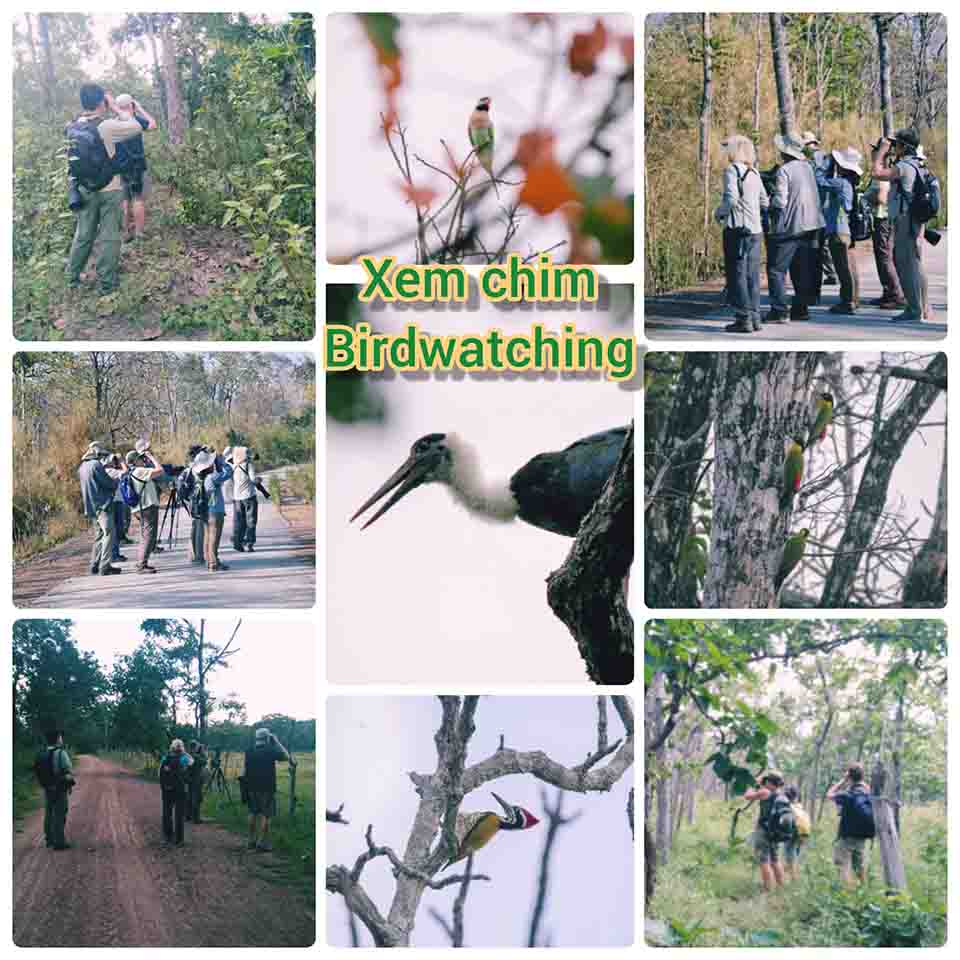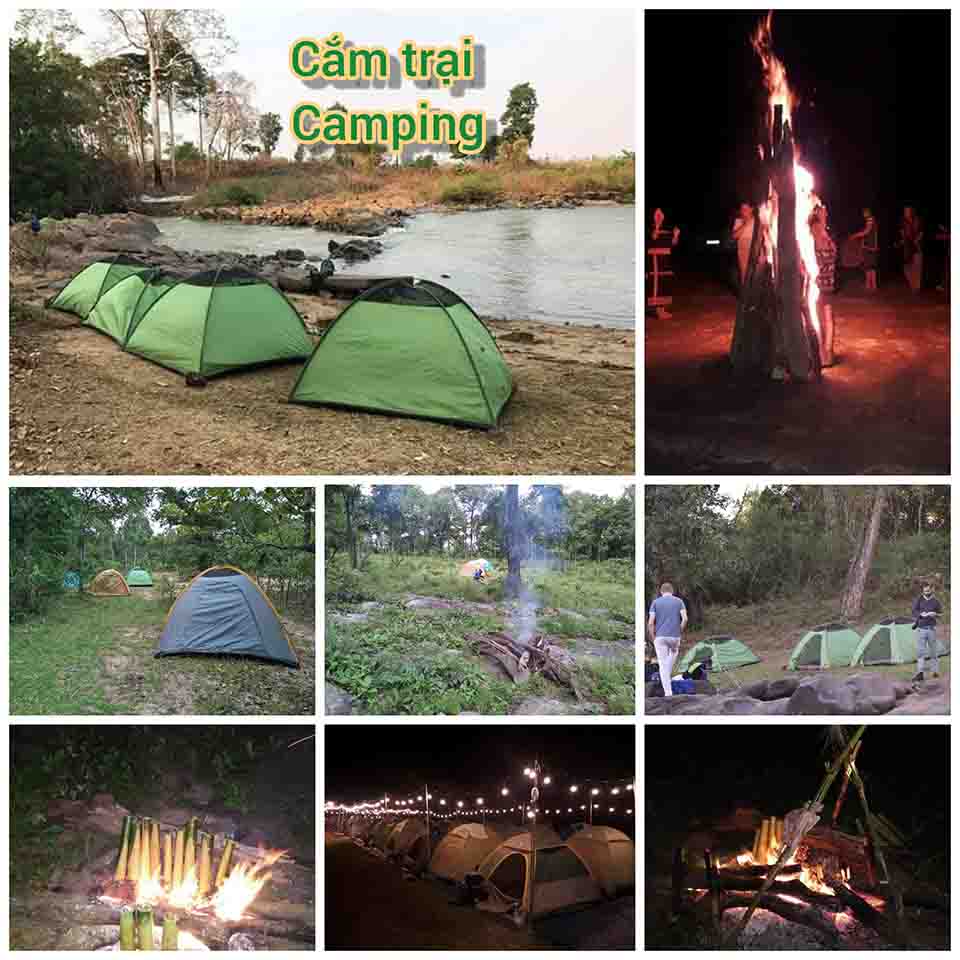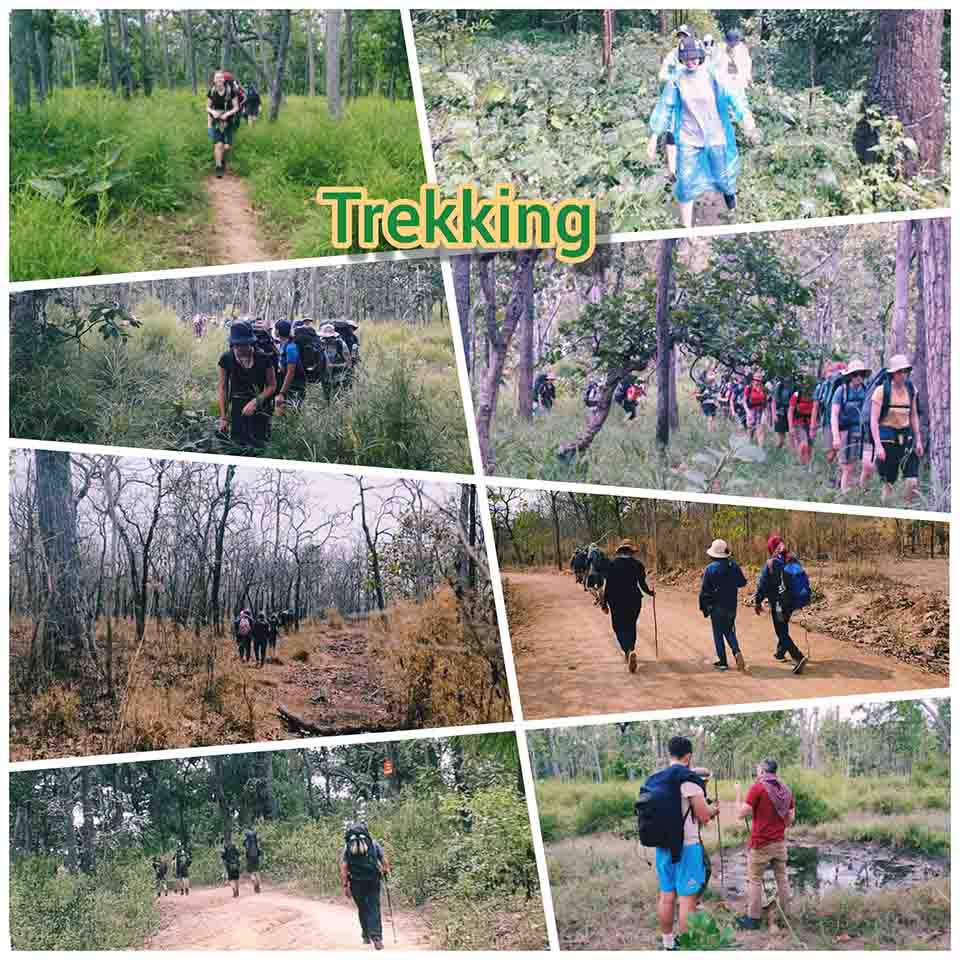
About Yok Don National Park
1. General introduction about Yok Don National Park:
Yok Don National Park (YDNP) covers an area of 115,545 hectares, the second largest National Park in the country. The forest area of the Park and the buffer zone is located on the administrative boundaries of 7 communes, 3 districts and 2 provinces, Dak Lak and Dak. It is 38 km from Buon Ma Thuot city. YDNP is the only dipterocarp forest ecosystem conservation area in Vietnam. Yok Don National Park has high biodiversity with 1,006 species of plants, 650 species of animals, including many endemic animals and plants. Endangered, precious and rare species such as elephants, gaurs, ungulates and precious trees. Yok Don National Park is considered as a potential place to provide services for scientific research, study and tourism. In addition, with the diverse existence of long-standing indigenous cultures of ethnic minorities living in the buffer zone, Yok Don National Park is also recognized as the cultural tourism center of the Western highland region. This is also the only national park that has a friendly tourism model with domestic elephants and wild elephants in their natural habitat. Every year, it attracts many domestic and international tourist groups to visit.
2. Formation and development process:
With the special position, role and importance of Yok Don forest, in 1992 the Minister of Forestry issued Decision No. 301/TCLD dated June 24, 1992 on the establishment of Yok Don National Park (NP) under the Ministry of Forestry with a forest area assigned for management and protection of 58,200 ha; on April 18, 2002 the Prime Minister issued Decision No. 39/2002/QD-TTg on the expansion of Yok Don National Park area to 115,545 ha; The project "Planning for conservation and sustainable development of Yok Don National Park for the period 2010 - 2020" was approved by the Ministry of Agriculture and Rural Development in 2012. On 11/11/2013, Prime Minister The Government issued Decision No. 2162/QD-TTg approving the "Master plan on tourism development in the Central Highlands until 2020, with a vision to 2030", of which, Yok Don National Park is identified as a National tourism for sightseeing, scientific research, discovery, adventure, national cultural identity and relaxation.
The local community living around Yok Don National Park is very poor, lacks productive land, and relies heavily on unsustainable exploitation of forest resources. The development of ecotourism with the participation of people in Yok Don National Park is one of the optimal solutions to help people develop a sustainable economy, thereby minimizing negative impacts on the environment. Natural resources make an important contribution to hunger eradication, poverty alleviation and new rural construction, ensuring social security, maintaining national defense, security and social order and safety.
3. Geographical location, topography and climate.
Yok Don National Park is located 400 km from Ho Chi Minh City to the North and 40km Far from Buon Ma Thuot city, Dak Lak province to the West. The park is located on the administrative territory of Krong Na, Eahaur and Eawen communes of Buon Don district; Ea Bung and Cu M'lanh of Ea Sup district; Dak Wil, Eapo of Cu Jut district, Dak Nong province.
Geographic coordinates: 12045' - 13010' North latitude; 107029’30” - 107048’ 30” degrees East longitude.
Climate: Tropical monsoon climate has two distinct seasons; rainy season from May to November and dry season from December to April.
Temperature: Average from 24 - 26 degrees celsius; the highest in May, the lowest in January.
Rainfall: 1500 - 2000mm/year. The highest month: 280 mm (June), The lowest month: 0 mm (January). Humidity 76% rain between May and November.
About boundaries.
According to Decision No. 39/QD-TTg, Yok Don National Park has the following boundaries:
+ The North of the border is along the road from Cu M'Lan (provincial road 1A) through border line 2 to the Vietnam - Cambodia border.
+ The South borders with Cu Jut district and runs along road 6B from km 22 + 500 to Dak Dam stream.
+ The East boundary runs along provincial road 1A from Cu M'Lan junction to Ban Don and then upstream Srepok river to the boundary of Cu Jut district.
+ The West is along the Vietnam - Cambodia border.
5. The rich diversity of flora and fauna of Yok Don National Park.
Flora: Yok Don National Park is considered as a living museum to study the historical origins of evolution, the relationships between the types of evergreen forest, semi-evergreen forest and tropical dry broadleaf deciduous forest. (Dipt forest), this is a unique natural forest ecosystem typical of Vietnam and the world.
Biodiversity studies conducted in the Park have discovered 1,006 species of plants, belonging to 132 families and 464 genera. The number of plant species capable of providing timber with a diameter of 20cm or bigger is more than 120 species, including many species such as Dau Tra Beng, Dau Long, Cam Lien, Ca Te, Giang Huong, Cam lai, and 64 species of plants that can be used for medicinal purposes.
Scientists have also discovered that the above plant species combine to form a large forest covering more than 90% of the Park area and divided into 3 main types as follows
+ Sparse, seasonally deciduous, broad-leaved forest (Dipterocarpus forest): is the dominant forest type in the entire Park. The characteristic of this forest type is the thin layer of trees, the foliage is discontinuous, and the leaves are deciduous in the dry season. As a result, the amount of light that can reach the ground is very large, creating conditions for the forest to regenerate and the grass to grow well.
+ Closed, broad-leaved evergreen forest (Evergreen forest): The typical flora of this type of forest are the trees of Hopea ferrea and Hopea odorata, along rivers and streams, which are corridor forests with the predominance of 2 species of bamboo: Bamboo La Nga, and Bamboo with Thorns (Bambusa arundinacea Retz). Interspersed between the bamboo bushes emerge giant trees of Dipterocarpus forest.
+ Semi-deciduous closed forest: Developing in the transitional zone between the two types of deciduous forest (dipterocarp) and evergreen forest, which is semi-evergreen forest, with a distinct advantage of Lythraceae species, which is easily recognized from afar.
Among the above forest types, the tropical dry deciduous broadleaf forest (Dipterocarpus forest) is the typical forest type of the dry region of South Indochina. In the forest, there are many growing grasslands with more than 60 species of grass family, so this is a suitable habitat for many large mammals such as elephants, gaurs, cows, bears, and deer.
Fauna: The fauna of the Park is very rich and unique with 92 species of mammals belonging to 30 families, 12 orders; 373 bird species belonging to 70 families, 7 orders; 55 species of reptiles, 18 species of frogs, 112 species of fish, and about 437 species of insects. Among these, there are 41 species of mammals, 22 species of birds, and some rare reptiles have been included in the Vietnam Red Book such as Ca Toong deer (Cervus eldii MClellan, 1842), Gray cow (Bos sauveli Urbain, 1937), gaur (Bos gaurus Smith, 1827), bison (Bos javanicus d'Alton, 1823), buffalo (Bubalus bubalis (Linnaeus, 1758)), leopard (Panthera pardus (Linnaeus, 1758)), tiger (Panthera tigris (Linnaeus, 1758)), peacock (Pavo muticus Linnaeus), backed pheasant (Lophura nycthemera), purple hiped pheasant (Lophuradiardi), flying squirrel (Pteromyidae), Hong Hoang (Buceros bicornisLinnaeus), crocodiles. A special feature of the precious animals here lives in large and concentrated populations. Yok Don National Park is the only area in Vietnam that preserves the type of dry forest of the Dauaceae family, which has many rare and large mammal species with a large population.
6. Cultural - historical value.
In addition to the high biodiversity values, Yok Don National Park is also a place to discover the unique cultural values of the Central Highlands ethnic groups. Many traditional architectural features from the past as well as the customs and habits of local residents are still preserved.
Visiting Yok Don National Park, visitors can visit villages, learn customs, attend festivals, rest in cool stilt houses; enjoy special dishes and drinks such as: bamboo rice, jar wine, and grilled chicken. In the evening, visitors can participate in cultural exchange performances of gongs, singing and dancing along. Traditional dances with musical instruments made from bamboo are full of creativity. You are told about vivid legends associated with the formation of mountains, rivers and streams.
The area of Yok Don National Park is considered a place of exchange and convergence of ethnic communities, considered the first capital of Dak Lak province. In the area, there are still traces of revolutionary historical relics formed during the resistance wars against foreign invaders such as the Ho Chi Minh trail, and ferry crossing. These are historical relics, full of attractiveness for visitors.
7. Environmental and landscape values:
Yok Don National Park has a poetic and lyrical landscape. In the middle of the vast forest, there is the legendary Sre Pok River flowing through. This river is created by two tributaries of Krong No and Krong Ana rivers creating many majestic rapids, waterfalls flowing all year round with the relatively cool climate and the fresh air.
8. Tourist service in Yok Don National Park
Organize internship programs, research on animals and plants, Experience with elephants, trekking, Environmental education activities, mountain bike rental, Dugout yachts, motor boats on the river, watching birds and animals, cultural exchange of gongs, guest houses, hammocks, camping, serving food and drinks, festivals, and seminars.
9. Accommodation:
Yok Don Guest House: Yok Don National Park has 03 guest houses with 19 airy rooms and full equipment. Guest houses are built in beautiful locations. All rooms have windows overlooking the river or lake or forest so you can breathe the fresh, cool air. You will feel more comfortable and healthy after staying at the guesthouse in Yok don National Park
Tourist camp: A tourist camp is a convenient type of accommodation for those who really love nature and want to immerse themselves in nature to enjoy the sounds of insects and animals, listen to the birdsong, the sounds of the wild animals. The camp has a mosquito net, a rain cover, a mattress,and a pillow. Staying in a tourist camp, you will feel comfortable after hard working days and like escaping from the noisy city environment to relax. Immerse yourself in the beautiful nature.
You can bring a light, beautiful, comfortable camp and choose for yourself a beautiful location, suitable for spending a night in nature to feel the wonders.
10. Attractions
Seven-branched waterfall: This is an ideal attraction as well as the only place where the Serepok River is divided into seven branches, creating many beautiful scenes to attract tourists.
Buddha Waterfall: According to locals, a long time ago their ancestors met a number of monks on missionary missions. When they came here, they met the river, so they could not cross it. They camped on the riverbank next to a waterfall for a while to find a way to cross the river. That's why people here call the name Buddha Waterfall.
Dak Lau, Dak tol, and Dak ken are natural streams winding like lovely dragons. In the dry season, the water is as clear as a mirror reflecting the trees. You can enjoy sightseeing and relaxing fishing to enhance your visit.
Yok don Mountain: The highest mountain is a beautiful symbol and was chosen to name the National Park. In the M'Nong’s language, Yok means mountain, Don means hill. So we can understand the meaning of the word Yok Don which is a high mountain made up of hills. This is a mountain covered with evergreen forest and dipterocarp forests creating a beautiful landscape.
Local people say that Yok Don mountain has a mysterious and sacred nature. If the person before climbing the mountain has bad intentions such as hunting wild animals or cutting trees, then the person will get lost and cannot find the way back.
Join the tour program to conquer the peak of Yok Don mountain with an altitude of 482m and enjoy the majestic beauty and feel the sacredness of the mountain.
Jang Lanh, Drang Phok, Buon Don villages: These are villages that have settled for a long time in the buffer zone of Yok Don National Park. Ethnic minorities here are mainly Ede, M'nong and there are some other people who have migrated from other places such as Lao, Tay, Muong groups... creating a multi-ethnic culture. They have different customs and habits compared to the Kinh people, there are very special traditional festivals with features of the Central Highlands.
Visiting Yok Don National Park to discover the unique ecosystem of primeval forest, observe animals, participate in activities to experience nature, enjoy the fresh air, visit villages, discover the beauty of customs and practices and attend traditional festivals of the Central Highlands...hopefully, you will be satisfied with the tours in Yok Don National Park.

Elephant Experience tour at Yok Don

Birdwatching at Yok Don

Camping at Yok Don

Trekking at Yok Don
Link nội dung: https://mozart.edu.vn/yok-don-a42773.html